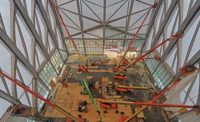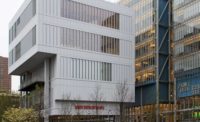It’s the slider phone of buildings.
The telescoping exoskeleton of the Shed, New York City’s new arts center that opened April 5, glides on six 6-ft-tall steel wheel assemblies upon 273-ft-long tracks adjacent to the High Line elevated park. When unused, the shell sits snugly over the structure’s static portion.
But when deployed—the way some early 2000s cellphones’ large screens covered or revealed their keypads—the 120-ft-tall husk, an exposed steel diagrid frame clad in 70-ft panels of a translucent Teflon-based polymer commonly called ETFE, covers the second-story plaza on the building’s east side. The space becomes the 7,000-sq-ft McCourt theater, which can be enclosed or open air and is warmed by a radiant heat floor plate.
If the area’s 1,250 seats or 2,000 standing room occupancy can’t accommodate crowds, the glass walls of two column-free galleries on the second and fourth stories can be opened, turning those sections into balconies and expanding capacity to 3,000 heads.
During a press event, team members on the $404-million project explained the materials, mechanics and structural design that are repurposed from the shipping, sailing and construction industries.
“The technology that moves it is [adapted] from gantry cranes,” says architect Liz Diller of Diller Scofidio + Renfro, part of the design team that includes David Rockwell of Rockwell Group. “We’ve added technology that hoists—cranes, [sports stadiums’ retractable] roofs—into a building,” Diller explains.
The steel and kinetic systems were prefabricated in Italy, she says, by a fabricator that does infrastructure projects like the Panama Canal. The sled drive, on the base building’s roof, is a rack-and-pinion system with motors totaling 180 horsepower—less than an SUV’s engine, but sufficient, since the cladding insulates like glass but is only one one-hundredth of the weight, according to Diller.
Though the skin lets in light, certain performances will require blackout conditions, in terms of sun and sound. To create heavy black shades that help the shell muffle 108 decibels of live pop music, the team tapped a sailmaker, says Dan Doctoroff, chairman of the Shed’s board of directors. When not needed, the shades roll back and the sides of the shell can slide up “like a garage door,” Doctoroff says, transforming the space into a sort of open-air band shell.






Post a comment to this article
Report Abusive Comment